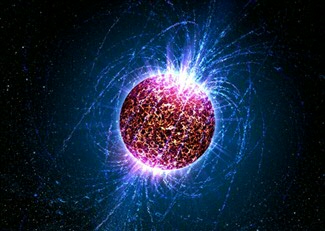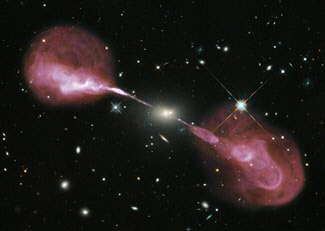High-Energy and Astroparticle Physics

At the very end of the life of a very massive star (>~ 8 solar masses) gravity can force the protons and electrons in the core of the star to combine into neutrons, forming a neutron star (~1-2 solar masses, radius of 10-15 km). The rest of the star is blown away in this process, also known as a Supernova Type II. Further collapse is prevented by the repulsion between the neutrons due to the Pauli exclusion principle (also known as the pressure of a degenerate neutron gas). Neutron stars have strong magnetic fields and are fast rotators. Pulsars are also believed to be neutron stars, that rotate so fast that they emit a beam of radiation along their magnetic axis, which is not necessarily aligned with their rotation axis. Just like a lighthouse, when this beam points towards earth it can be picked up as a pulsar.
In even more massive stars the core can be so massive that no known mechanism can prevent further collapse into a singularity: A black hole forms. These are objects have the strongest gravitational fields in the universe. Even light cannot escape once too close to the singularity. Quantum mechanical effects do however allow black holes to emit the so-called Hawking radiation and eventually vaporise, long after the last stars in the universe died. Their strong gravitational attraction attracts gas from nearby stars, which forms a disc when it is accreted, and heats up so much that it can emit X-ray radiation. We can learn about the dynamics in the vicinity of the black hole by studying the emission in the X-ray bands. There are also strong reasons to believe the centres of galaxies often host supermassive black holes, and some even show their activity as AGNs and quasars. Both neutron stars and black holes also show imprints of the curvature of space-time as predicted by General Relativity, which has strong implications for astrophysics and cosmology in general.

Kapteyn research focuses on the physics of accretion onto neutron stars and low-mass black holes, the effects of extremely strong gravitational fields, and the internal composition of neutron stars. In particular the following questions are being persued: What are the properties of matter under the extreme conditions prevalent in the interior of a neutron star? Furthermore, what are the observational signatures of black holes, how do nearby particles and radiation behave, and can we observationally
verify the extraordinary predictions of general relativity for the properties of curved space-time near these objects?
Future directions of high energy astrophysics focus on the proposed X-ray space telescope ATHENA together with SRON. Furthermore the use of ALMA, and the use of APERTIF (ARTS) in studying pulsars, rotating radio transits, and fast radio bursts.
Scientific staff working in this field are: Barthel, Mendez, Wang
